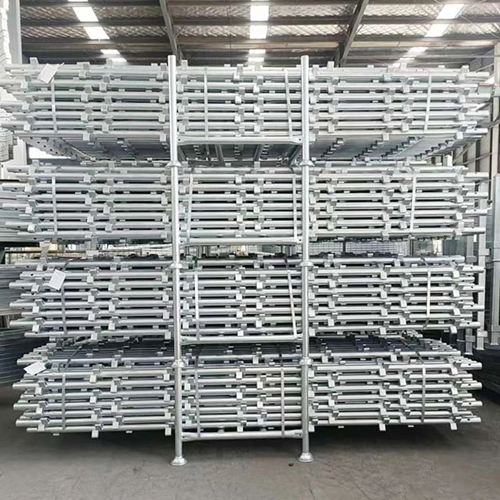
Scaffolding systems like Kwikstage and Ringlock are integral to modern construction, yet they differ significantly in design, functionality, and suitability for projects. Understanding these distinctions helps in selecting the optimal system for specific needs.
1. Connection Mechanism
Kwikstage: Employs a wedge-locking system. Vertical standards feature pre-welded V-shaped lugs, where horizontal ledgers and transoms are secured using gravity-driven wedges. This tool-free design enables rapid assembly without bolts or screws.
Ringlock: Utilizes a rosette-ring system. Vertical standards have circular rings (rosettes) at intervals, into which horizontals (ledgers) and diagonals (braces) are inserted and locked with pins or wedges. This allows multi-directional connections, enhancing adaptability for complex structures.
2. Components and Assembly
Kwikstage: Comprises vertical standards, ledgers, transoms, and platforms. Its simplicity allows quick installation, ideal for repetitive tasks. The wedge system minimizes alignment precision, speeding up setup.
Ringlock: Includes verticals with rosettes, horizontals, diagonals, and specialized components like base jacks. The ring system demands precise alignment but offers greater flexibility in configuring angles and bracing, improving structural integrity.
3. Load Capacity and Stability
Kwikstage: Suitable for general construction (e.g., brickwork, painting) with a robust load-bearing capacity. However, it is less optimized for extremely heavy loads compared to Ringlock.
Ringlock: Excels in heavy-duty applications due to its interlocking ring design and enhanced bracing. The distributed load across multiple connection points makes it preferred for shoring, industrial projects, and large-scale infrastructure.
4. Versatility and Applications
Kwikstage: Highly versatile for standard projects like residential buildings, commercial facades, and maintenance. Its modularity adapts to most shapes but is less ideal for intricate configurations.
Ringlock: Superior for complex geometries (e.g., curved structures, bridges) due to multi-angle connections. Commonly used in oil refineries, shipbuilding, and high-rise constructions where stability under heavy loads is critical.
5. Regional Popularity and Cost
Kwikstage: Dominant in Commonwealth nations (UK, Australia, New Zealand) due to its cost-effectiveness and ease of use for medium-scale projects.
Ringlock: Favored globally for large-scale, high-budget projects. While initially more expensive, its durability and adaptability justify costs in demanding environments.
6. Safety and Compliance
Both systems meet rigorous safety standards, integrating guardrails, toe boards, and non-slip platforms. Ringlock’s rigid nodal connections may offer marginal stability advantages in extreme conditions, but Kwikstage remains reliable for typical scenarios.
Conclusion
Kwikstage scaffolding prioritizes speed and simplicity, making it a go-to for routine construction tasks. In contrast, Ringlock’ s advanced design caters to heavy-duty and geometrically complex projects. The choice hinges on project scope, load requirements, and budget, with both systems epitomizing innovation in temporary structural support.











